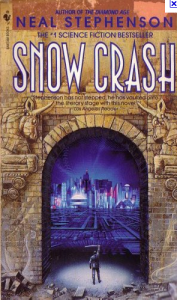Source Text: Stephenson, Neal. Snow Crash. New York: Bantam Books, 1992. Print.
Entry Author: Erin O’Kelly
While his ability to deal with the plot twists leading up to the final showdown is not predicated on his race, the course of the story makes several turns that do rely on racially charged events to get from plot point A to plot point B to plot point Z.Hiro’s role in the novel covers everything from gathering information to protecting himself and others to chopping people up with swords and, interestingly, his mixed heritage makes subtle but important contributions in all of those areas. He uses his heritage as an American Black to make get the social results he wants in some situations, like when he forces a confrontation with a Japanese pop star to make sure that a concert he organized goes on as planned: “What the hell. This is America, Hiro is American, and there’s no reason to take this politeness thing to an unhealthy extreme” (Stephenson 132). Similarly, in the novel’s world of racially-specific closed-gate communities, a type of franchise called “burbclaves”, his Korean ancestry gives him an in to the city-franchise Mr. Lee’s Greater Hong Kong. Without that access to the refuge of a Greater Hong Kong that his citizenship affords him, he and one of the other main characters, YT, would have likely been taken out of commission in the first hundred pages by a bunch of angry taxi drivers; later on, his ability to access the Asian-centric franchise saves him from getting shot by a bunch of Russian gunmen. His ability to bring YT into this otherwise off-limits sphere of influence also advances the plot by setting the stage for a later karmatic payback for an act of kindness performed during her stay.
The attention his mixed heritage attracts is not entirely benign, however, and also singles him out as a target for curiosity and animosity. Many people are unable to peg his ethnic background, and others’ misinterpretations spark conflict. One Japanese businessman who thinks his black heritage should deny him the use of his inherited Japanese swords challenges his honor and right to hold the weapons (Stephenson 85). A later scene makes him a target for racists who aren’t sure what his heritage is, exactly, but know they don’t like it and can’t figure out which epithet to call him (Stephenson 301). Despite this, a majority of the attention paid to Hiro’s heritage is narrative, not part of any dialogue. Although the reader is up-to-date on the matter, Hiro doesn’t usually bother to correct the person doing the mislabeling. He simply continues doing what he always does: making effective uses of both sides of his heritage to accomplish what he wants or needs to do, and saving a good chunk of the world in the process.

